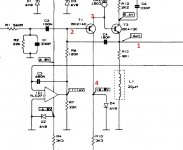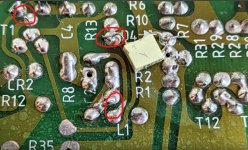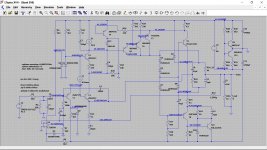Due to being long-sighted (age related). I bridged R13 to C2 on the left channel and lost output in that channel. Since removing the offending solder bridge, I now have +19v DC in that channel. I read somewhere that if you have positive DC offset that means you have a problem on the negative rail. Would that be the case here?
Does anyone know where to look for damaged components? I have a Peak Atlas DCA55 and a multimeter. I also have a desoldering station for quick component removal.
Here's where I messed up:

And here's a link to the circuit diagram.
https://www.audioservicemanuals.com/q/quad/quad-306/19924-quad-306-service-data
Does anyone know where to look for damaged components? I have a Peak Atlas DCA55 and a multimeter. I also have a desoldering station for quick component removal.
Here's where I messed up:
And here's a link to the circuit diagram.
https://www.audioservicemanuals.com/q/quad/quad-306/19924-quad-306-service-data
These things happen 
You need to check the voltage across Zener diode D4 and check it is around negative 6.8 volts. Also first check it is not short circuit.
Check R13 is still OK and not open circuit.
It is possible the input transistors have suffered. Voltage checks would go a long way to proving that but I can't tell you what the voltages might be with a faulty amp, what you are looking for are voltages that are implausible such as low base/emitter volts.
If you measure and record the voltage at these four marked points it might help. All measured from ground to begin with. I'll look in later

You need to check the voltage across Zener diode D4 and check it is around negative 6.8 volts. Also first check it is not short circuit.
Check R13 is still OK and not open circuit.
It is possible the input transistors have suffered. Voltage checks would go a long way to proving that but I can't tell you what the voltages might be with a faulty amp, what you are looking for are voltages that are implausible such as low base/emitter volts.
If you measure and record the voltage at these four marked points it might help. All measured from ground to begin with. I'll look in later

Hmmm, thanks... I was hoping it would be more clear cut... and its not 
T3 is reverse biased and the base of T1 is being pulled negative. One further quick check would be to measure the voltage on pin 7 of the opamp (junction of R6 and R7) to see if that is massively negative.
I think you are going to end up having to measure T1 and T3 out of circuit and if in doubt replace them.
What I'm looking for are any low impedance paths that the short could have allowed high current to pass and there aren't any. R22 in the bridge should be checked as that has a high DC voltage across it in the fault condition.
Also are you 100% sure there are no other unnoticed shorts or solder blobs anywhere?
T3 is reverse biased and the base of T1 is being pulled negative. One further quick check would be to measure the voltage on pin 7 of the opamp (junction of R6 and R7) to see if that is massively negative.
I think you are going to end up having to measure T1 and T3 out of circuit and if in doubt replace them.
What I'm looking for are any low impedance paths that the short could have allowed high current to pass and there aren't any. R22 in the bridge should be checked as that has a high DC voltage across it in the fault condition.
Also are you 100% sure there are no other unnoticed shorts or solder blobs anywhere?
Have you also measure across capacitor C10 & C11 ... they should be equal or very close, ... if not I am afraid that any other values will be far away from nominal values.Hmmm, thanks... I was hoping it would be more clear cut... and its not
T3 is reverse biased and the base of T1 is being pulled negative. One further quick check would be to measure the voltage on pin 7 of the opamp (junction of R6 and R7) to see if that is massively negative.
I think you are going to end up having to measure T1 and T3 out of circuit and if in doubt replace them.
What I'm looking for are any low impedance paths that the short could have allowed high current to pass and there aren't any. R22 in the bridge should be checked as that has a high DC voltage across it in the fault condition.
Also are you 100% sure there are no other unnoticed shorts or solder blobs anywhere?
Before I go any further. Back when I cleaned the solder side of the board with 99% alcohol, I put on a bit too much, and it leaked through to the front. It seemed to leave a shiny residue in places. Using a toothbrush, cotton buds and more alcohol, I managed to remove it, but did wonder if it was conductive, and also wondered if some of it got underneath the RCA sockets (it's tight to the PCB, so can't be seen). Could this problem be caused by the left input shorting to ground?
Hmmm, thanks... I was hoping it would be more clear cut... and its not
T3 is reverse biased and the base of T1 is being pulled negative. One further quick check would be to measure the voltage on pin 7 of the opamp (junction of R6 and R7) to see if that is massively negative.
I think you are going to end up having to measure T1 and T3 out of circuit and if in doubt replace them.
What I'm looking for are any low impedance paths that the short could have allowed high current to pass and there aren't any. R22 in the bridge should be checked as that has a high DC voltage across it in the fault condition.
Also are you 100% sure there are no other unnoticed shorts or solder blobs anywhere?
Junction of R6/R7 measures -6.77v
Across C10 & C11 is 76v
R22 measures 560R
T1 (BC214C)
HFE = 373
VBE = 0.802v
Leakage current 0mA
T3 (BC413C)
HFE = 428
VBE = 0.768v
Leakage current 0mA
Yes, I know temperature has a massive effect on transistor measurement results, but I don't understand the relevance of the figures, so posted them anyway.
I'll have another check to see if there are any shorts...
Junction of R6/R7 measures -6.77v
Pretty much as expected tbh, the servo has swung to the negative 6.8v rail to try and correct the problem and which of course it can not.
Across C10 & C11 is 76v
I think what @audiofan was meaning is what is the voltage across each. They should be an equal split of the total supply, so 38 volts across each. Its a neat arrangement, a form of virtual ground. Worth checking.
I've no quick answers for this one I'm afraid. What would be very useful assuming the voltage across C10 and C11 are reasonably correct would be print of the circuit with the voltage at all transistor nodes. The 'loop' is broken somewhere. The output has a positive offset and the servo is correctly swinging negative to try and correct that and that is not happening. So somewhere there is a major failure but we have to consider that it could be anywhere.
Some of the soldering looks a bit flaky tbh. Not sure on that tiny 'sliver' of something. It may just be a scratch in the board.

I'll check those and report back...Check D1, D2, R3, R4.
Pretty much as expected tbh, the servo has swung to the negative 6.8v rail to try and correct the problem and which of course it can not.
I think what @audiofan was meaning is what is the voltage across each. They should be an equal split of the total supply, so 38 volts across each. Its a neat arrangement, a form of virtual ground. Worth checking.
I've no quick answers for this one I'm afraid. What would be very useful assuming the voltage across C10 and C11 are reasonably correct would be print of the circuit with the voltage at all transistor nodes. The 'loop' is broken somewhere. The output has a positive offset and the servo is correctly swinging negative to try and correct that and that is not happening. So somewhere there is a major failure but we have to consider that it could be anywhere.
Some of the soldering looks a bit flaky tbh. Not sure on that tiny 'sliver' of something. It may just be a scratch in the board.
View attachment 1034345
Voltage across C10 and C11 looks very wrong:
I thought you'd pick up the bad soldering on the cap across D4 Lol (sorted now).Pretty much as expected tbh, the servo has swung to the negative 6.8v rail to try and correct the problem and which of course it can not.
I think what @audiofan was meaning is what is the voltage across each. They should be an equal split of the total supply, so 38 volts across each. Its a neat arrangement, a form of virtual ground. Worth checking.
I've no quick answers for this one I'm afraid. What would be very useful assuming the voltage across C10 and C11 are reasonably correct would be print of the circuit with the voltage at all transistor nodes. The 'loop' is broken somewhere. The output has a positive offset and the servo is correctly swinging negative to try and correct that and that is not happening. So somewhere there is a major failure but we have to consider that it could be anywhere.
Some of the soldering looks a bit flaky tbh. Not sure on that tiny 'sliver' of something. It may just be a scratch in the board.
View attachment 1034345
It was just a hair above L1, and T1 is fine.
I think I've found a mistake. I'm pretty sure the small caps are supposed to go across the diodes, but the one that's supposed to go across D1, goes to the pad of R26 and C9. I've checked D1, D2, R3 and R4 and they are ok.
It won't be a fault rectifier if you have the correct total supply voltage... which I think you have at 76 volts.
Although it might sound daunting it really is going to be best to get a full picture of all the voltages in the faulty channel. You can list them in the form:
T1
B=
C=
E=
T2
B=
C=
E=
and so on.
One random thought as you are modifying and altering this is that the 'fault' isn't actually a DC problem but rather an AC issue caused by oscillation. The only way to prove that would be with a scope. In the first instance I think clear voltage checks are the way to go.
This shows approximate correct voltage. What we are looking for is a 'break' in the loop somewhere and a step change from one stage to the next that doesn't make sense.

Although it might sound daunting it really is going to be best to get a full picture of all the voltages in the faulty channel. You can list them in the form:
T1
B=
C=
E=
T2
B=
C=
E=
and so on.
One random thought as you are modifying and altering this is that the 'fault' isn't actually a DC problem but rather an AC issue caused by oscillation. The only way to prove that would be with a scope. In the first instance I think clear voltage checks are the way to go.
This shows approximate correct voltage. What we are looking for is a 'break' in the loop somewhere and a step change from one stage to the next that doesn't make sense.

I would firmly attach the meter negative to ground first (say the speaker negative socket) and then carefully probe each node. If you feel unsteady probing then perhaps insulate most of the probe tip so that it is 'difficult' to short anything. Also look for other nearby parts that connect to where you want to measure and see if they are more accessible.
- Home
- Amplifiers
- Solid State
- Quad 306 High DC offset in left channel